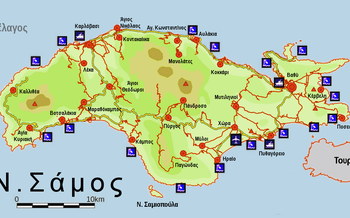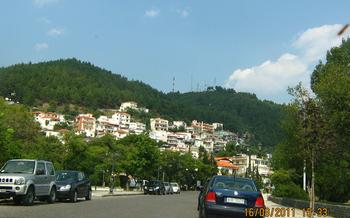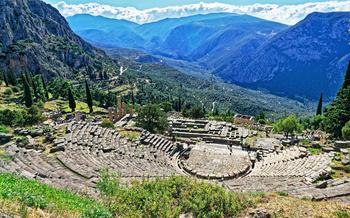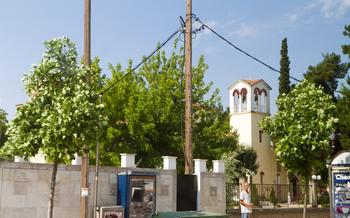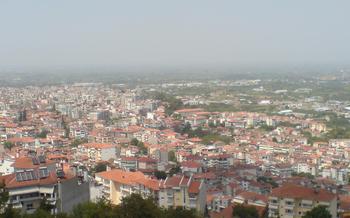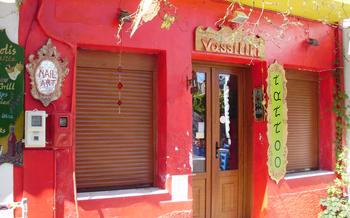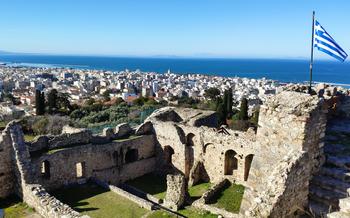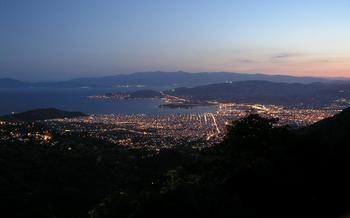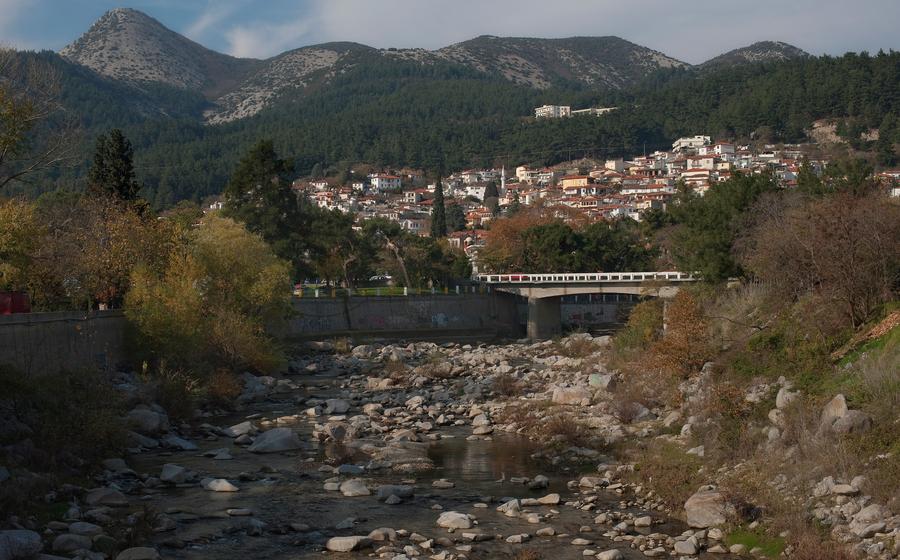
Porto Lagos and the St. Nicholas Monasteries
- A Journey to Porto Lagos
- Exploring the Enchanting St. Nicholas Monasteries
- Porto Lagos Beach
- The Lagoon's Ecosystem
- The Village of Porto Lagos
- The St. Nicholas Monastery on the Island
- The St. Nicholas Monastery in the Forest
- The Icon of St. Nicholas
- The Monasteries' Role in Byzantine Art and Culture
- The Monasteries' Contribution to Education and Charity
- The Monasteries' Architectural Treasures
- The Monasteries' Spiritual Significance
- The Monasteries' Contribution to the Greek Orthodox Church
- The Monasteries' Resilience and Survival:
- Insider Tip:
A Journey to Porto Lagos
Porto Lagos is a captivating coastal village nestled in the embrace of Northern Greece, beckoning travelers with its rich history, pristine beaches, and natural wonders. Once a significant port during the Byzantine era, Porto Lagos retains a timeless charm, inviting visitors to delve into its captivating past. The village's allure extends beyond its historical significance, as it boasts an array of pristine beaches that beckon with their golden sands and crystal-clear waters, promising an idyllic escape for sun-seekers and beach enthusiasts.
Venturing further into Porto Lagos, one encounters a unique ecosystem, centered around a mesmerizing lagoon that serves as a haven for an array of flora and fauna. The lagoon's tranquil waters and lush vegetation create a serene sanctuary, where nature enthusiasts can immerse themselves in the beauty of the natural world. Beyond its natural wonders, Porto Lagos exudes a palpable charm, with its cobbled streets and traditional Greek tavernas, offering a glimpse into the village's rich cultural heritage and welcoming spirit.
Exploring the Enchanting St. Nicholas Monasteries
The allure of the St. Nicholas Monasteries lies in their rich history, spiritual significance, and architectural beauty. These two sacred havens, one situated on a serene island and the other nestled amidst a lush forest, offer visitors a profound and awe-inspiring experience.
Established in the 10th century, the monasteries have stood as symbols of faith and devotion for over a millennium. Their history is interwoven with tales of piety, miracles, and the unwavering dedication of the monks who have dedicated their lives to serving God. The monasteries are considered sacred places, attracting pilgrims and visitors seeking spiritual solace and communion with the divine.
The architectural splendor of the monasteries is a testament to the skill and artistry of Byzantine craftsmen. The island monastery, with its whitewashed walls and intricate stone carvings, exudes an aura of serenity and timelessness. The forest monastery, surrounded by towering trees and vibrant flora, blends harmoniously with its natural surroundings. Both monasteries feature stunning frescoes and mosaics that depict biblical scenes and the lives of saints, offering a glimpse into the rich artistic heritage of the Byzantine Empire.
Within the monasteries' walls, visitors can immerse themselves in a serene and contemplative atmosphere. The melodious chanting of monks, the scent of incense, and the flickering candlelight create a mystical ambiance that fosters introspection and spiritual growth. The monasteries offer a sanctuary for those seeking respite from the hustle and bustle of modern life, providing a space for prayer, meditation, and connection with the divine.
Porto Lagos Beach
With its allure of sandy shores and crystal-clear waters, Porto Lagos Beach is a haven for sun-seekers and beach enthusiasts. The beach boasts a serene and tranquil atmosphere, making it an ideal spot for relaxation and unwinding. Visitors can soak up the sun's warmth while enjoying the gentle caress of the waves against their skin. The beach's crystal-clear waters offer excellent visibility, making it a popular spot for swimming, snorkeling, and diving.
For those seeking adventure and excitement, Porto Lagos Beach offers a range of water sports and activities. Visitors can thrill in the rush of windsurfing or kitesurfing, harnessing the power of the wind to glide across the water's surface. Kayaking and paddleboarding are also popular options, allowing visitors to explore the coastline and discover hidden coves and inlets.
The beach is well-equipped with amenities and facilities for visitors' convenience, ensuring a comfortable and enjoyable experience. Beach chairs and umbrellas are available for rent, providing shade and relaxation. There are also several tavernas and cafes nearby, offering a range of refreshments and local delicacies for visitors to savor as they bask in the beauty of their surroundings.
One of the unique features of Porto Lagos Beach is its significance as a nesting site for sea turtles. The beach provides a safe and protected environment for these majestic creatures to lay their eggs and ensure the survival of their species. Visitors are reminded to respect the turtles' nesting grounds and observe them from a distance to avoid disturbing their natural behavior.
The Lagoon's Ecosystem
Porto Lagos is renowned for its unique and diverse ecosystem, centered around the mesmerizing lagoon. This natural sanctuary is a haven for a plethora of flora and fauna, creating a rich tapestry of life. The lagoon's calm waters provide a nurturing environment for a variety of fish species, while the surrounding marshlands teem with a vibrant array of birdlife.
The lagoon's ecological significance extends beyond its aquatic inhabitants. It serves as a crucial stopover point for migratory birds, offering them respite and sustenance during their arduous journeys. The lush vegetation lining the lagoon's shores provides nesting sites for numerous bird species, including the endangered Dalmatian pelican.
Conservation efforts are diligently undertaken to protect and preserve the lagoon's delicate ecosystem. Visitors are encouraged to respect the fragile environment and minimize their impact on this natural treasure. Birdwatching enthusiasts can indulge in the delightful pastime of observing the diverse avian life from designated viewing areas, ensuring minimal disturbance to the wildlife.
The Village of Porto Lagos
Porto Lagos is a charming village located on the shores of the lagoon. Its history dates back to ancient times, and it has been influenced by various cultures, including Greek, Roman, and Byzantine. The village is known for its traditional architecture, with whitewashed houses and cobblestone streets. Visitors can explore the village's narrow alleys, admire the old churches, and visit the local museum to learn more about its rich history.
Porto Lagos is also a popular destination for culinary enthusiasts, as it offers a variety of traditional Greek dishes. Visitors can savor fresh seafood, homemade pastries, and local delicacies at the village's tavernas and restaurants. The village comes alive at night, with a vibrant nightlife scene offering bars, clubs, and live music venues.
The St. Nicholas Monastery on the Island
Perched atop a picturesque islet, the St. Nicholas Monastery stands as a testament to faith and architectural brilliance. The monastery's history is intertwined with the legend of a miraculous icon of St. Nicholas that washed ashore on the island centuries ago. Inspired by this divine sign, devout fishermen constructed a small chapel to house the sacred icon, which later grew into the magnificent monastery that stands today.
The monastery's design is a harmonious blend of Byzantine and local architectural styles, showcasing intricate stonework, vaulted ceilings, and graceful arches. The interior of the monastery is adorned with stunning frescoes and mosaics depicting scenes from the Bible and the life of St. Nicholas, creating an atmosphere of awe and reverence.
A visit to the St. Nicholas Monastery on the Island is a journey through time, where history, spirituality, and natural beauty converge. As you explore the monastery's serene courtyards, marvel at the intricate artwork, and soak in the breathtaking views of the surrounding sea and sky, you will feel a sense of peace and tranquility that can only be found in such a sacred space.
The St. Nicholas Monastery in the Forest
Nestled deep within a lush forest, the St. Nicholas Monastery exudes an air of tranquility and mysticism. The monastery's unique setting amidst nature creates a serene atmosphere that invites visitors to connect with the spiritual realm. The architectural style of the monastery is a blend of Byzantine and local influences, showcasing intricate stonework and elegant domes that seem to rise from the surrounding forest.
Legends and stories have been woven around the monastery throughout the centuries, adding to its allure. One tale speaks of a monk who, while meditating in the forest, was visited by a vision of St. Nicholas. The saint instructed the monk to build a monastery on that very spot, and thus the St. Nicholas Monastery in the Forest was born.
The monastery's spiritual significance is palpable, as it serves as a place of pilgrimage and prayer for many believers. Visitors are often drawn to the monastery's tranquil surroundings and the opportunity to immerse themselves in its spiritual atmosphere. Whether seeking solace, guidance, or a deeper connection with their faith, visitors to the St. Nicholas Monastery in the Forest are sure to find a sanctuary for the soul.
The Icon of St. Nicholas
The icon of St. Nicholas is a revered object of devotion among the local people. Believed to date back to the 13th century, the icon is said to possess miraculous powers and has been attributed with numerous healings and blessings. The faithful flock to the monasteries to venerate the icon, seeking its intercession and protection. Annual religious festivals and celebrations are held in honor of St. Nicholas, drawing thousands of pilgrims and visitors from around the region. These festivals showcase the deep devotion and spiritual connection that the local community feels towards the icon and the saint it represents.
The Monasteries' Role in Byzantine Art and Culture
The St. Nicholas Monasteries served as vital repositories of Byzantine art and culture, playing a pivotal role in its preservation and transmission. The monks meticulously preserved Byzantine manuscripts and artifacts within the monasteries' libraries, ensuring that this invaluable heritage remained intact. The monasteries' walls were adorned with intricate frescoes and mosaics, showcasing the exquisite artistry of the Byzantine era. These artistic masterpieces depicted religious scenes, biblical narratives, and historical events, offering a visual representation of Byzantine culture and beliefs.
Through their patronage of the arts, the monasteries fostered a vibrant artistic community, attracting skilled artisans and craftsmen to work within their walls. This patronage contributed to the development of Byzantine art, leading to the creation of unique and enduring masterpieces. Furthermore, the monasteries' architectural design and construction techniques reflected the influence of Byzantine architecture, showcasing the empire's distinct aesthetic sensibilities.
The monasteries served as centers of learning and scholarship, where monks engaged in the study of Byzantine literature, philosophy, and theology. They maintained extensive libraries containing a wealth of Byzantine texts, including historical chronicles, theological treatises, and scientific works. Through their dedication to scholarship, the monks ensured that Byzantine knowledge and wisdom were preserved and transmitted to future generations.
The Monasteries' Contribution to Education and Charity
The St. Nicholas Monasteries have played a significant role in education and charity throughout their existence. They were established as centers of learning, offering education to the local communities. The monks served as teachers, passing on their knowledge and wisdom to the younger generations. The monasteries maintained libraries containing valuable manuscripts and books, contributing to the preservation and dissemination of knowledge.
Beyond education, the monasteries were actively involved in charitable work, providing support and assistance to the local population. They established hospitals and infirmaries, offering medical care to those in need. The monks also distributed food, clothing, and other necessities to the poor and vulnerable. The monasteries' charitable endeavors extended to supporting orphans, widows, and the elderly, demonstrating their commitment to social welfare.
Through their educational and charitable initiatives, the St. Nicholas Monasteries made a profound impact on the communities they served. They fostered intellectual growth, alleviated suffering, and promoted social justice, leaving a lasting legacy of compassion and service.
The Monasteries' Architectural Treasures
The St. Nicholas Monasteries stand as testaments to the architectural ingenuity and artistry of their builders. Constructed during the Byzantine era, the monasteries showcase a harmonious blend of Byzantine and local architectural styles. Their exteriors are characterized by sturdy stone walls and graceful arches, while their interiors are adorned with intricate frescoes and mosaics that depict religious scenes and stories.
The frescoes and mosaics within the monasteries are particularly noteworthy for their vibrant colors, expressive figures, and detailed compositions. These artworks not only serve as decorative elements but also provide a glimpse into the beliefs and values of the Byzantine people. The monasteries' architectural features and artistic treasures have been carefully preserved and restored over the centuries, ensuring that they continue to inspire and captivate visitors to this day.
The Monasteries' Spiritual Significance
The St. Nicholas Monasteries hold immense spiritual significance, serving as centers of devotion and spirituality for centuries. The monks who reside in these monasteries dedicate their lives to prayer, meditation, and the pursuit of a deeper connection with the divine. They follow strict religious practices and traditions, adhering to the teachings of the Greek Orthodox Church.
Visitors to the monasteries can sense the profound spiritual atmosphere that permeates the air. The monasteries provide a sanctuary for those seeking solace, reflection, and spiritual growth. Pilgrims from all over Greece and beyond come to visit the monasteries, seeking blessings, guidance, and inner peace.
The monasteries also play a vital role in fostering spiritual growth and renewal. Through their teachings, prayers, and example, the monks help guide others on their spiritual journeys. They offer spiritual counseling, retreats, and workshops, providing opportunities for visitors to deepen their understanding of Orthodox Christianity and their own spirituality.
The St. Nicholas Monasteries stand as testaments to the enduring power of faith and the pursuit of a meaningful connection with the divine. They invite visitors to embark on a spiritual journey, to seek solace, guidance, and inner peace, and to experience the transformative power of faith.
The Monasteries' Contribution to the Greek Orthodox Church
The St. Nicholas Monasteries have played a significant role in preserving and promoting the traditions of the Greek Orthodox Church. As important institutions within the church, they have contributed to the spiritual and cultural identity of Greece. The monasteries have served as centers of Orthodox worship, where monks and pilgrims gather to celebrate religious festivals and observe sacred rituals. Through their dedication to prayer, fasting, and spiritual practices, the monks have helped to maintain the vitality and vibrancy of the Orthodox faith. Furthermore, the monasteries have actively promoted Orthodox teachings and traditions through education, outreach, and cultural activities, contributing to the dissemination and preservation of Orthodox Christianity in Greece and beyond.
The Monasteries' Resilience and Survival:
Throughout their long and storied history, the St. Nicholas Monasteries have faced numerous challenges and hardships. Natural disasters, wars, and political upheavals have all left their mark on these sacred institutions. Yet, despite these trials, the monasteries have endured, a testament to the resilience and determination of the monks who have dedicated their lives to preserving them.
In times of war, the monasteries often found themselves on the front lines, caught in the crossfire of battles and invasions. During the Ottoman occupation of Greece, the monasteries were subjected to persecution and forced conversions. However, the monks refused to abandon their faith and traditions, and they played a vital role in keeping the spirit of Greek Orthodoxy alive during this dark period.
Natural disasters have also posed a significant threat to the monasteries. Earthquakes, floods, and fires have all caused extensive damage over the centuries. But each time, the monks have rebuilt and restored their beloved monasteries, demonstrating their unwavering commitment to their sacred mission.
Despite these challenges, the St. Nicholas Monasteries have not only survived but thrived. They have continued to attract pilgrims and visitors from around the world, who come to marvel at their architectural beauty, experience their spiritual atmosphere, and learn about their rich history. The monasteries' resilience and survival are a testament to the enduring power of faith and the indomitable spirit of the human soul.
Insider Tip:
To make the most of your visit, plan your trip to coincide with one of the annual religious festivals held at the monasteries. These festivals draw large crowds of pilgrims and locals, offering a vibrant and immersive experience. During these celebrations, you can witness traditional rituals, processions, and feasts, gaining a deeper insight into the spiritual and cultural traditions of the region.
Remember to dress modestly and respectfully when entering the monasteries, as they are sacred places of worship. Guided tours are available for those who wish to delve deeper into the history, architecture, and spiritual significance of these remarkable sites. By combining a visit to the monasteries with a stay in the charming village of Porto Lagos, you can create a truly unforgettable and enriching travel experience.

